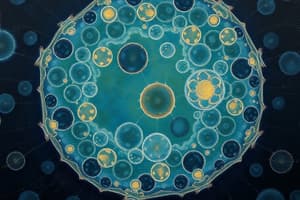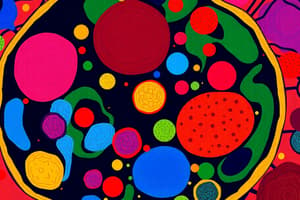Podcast
Questions and Answers
Modern Cell Theory tells us that: (mark all correct answers)
Modern Cell Theory tells us that: (mark all correct answers)
- All cells come from pre-existing cells. (correct)
- The cell is the basic structural and functional unit of life forms. (correct)
- All life’s energy flow (metabolism & biochemistry) occurs within cells. (correct)
- Free cell formation, similar crystals.
- Cells are only found in animals.
The kingdoms including organisms that are composed of eukaryotic cells:
The kingdoms including organisms that are composed of eukaryotic cells:
- Plantae, Animalia, fungi, protists, archaea
- Plantae, Animalia, archaea
- Plantae, Animalia, fungi, Protista (correct)
- Animalia, archaea, monera, Plantae
How many kingdoms contain organisms that have a cell wall? What are they?
How many kingdoms contain organisms that have a cell wall? What are they?
Four Kingdoms: Plantae, Monera (includes Eubacteria and Archaebacteria), Protista, and Fungi.
The domain of Prokaryotic included:
The domain of Prokaryotic included:
The domain of Eukarya included:
The domain of Eukarya included:
We can divide the cells into:
We can divide the cells into:
Which of the following is true about fungi?
Which of the following is true about fungi?
Which diagram shows a plant cell?
Which diagram shows a plant cell?
Which diagram shows one organ only?
Which diagram shows one organ only?
What is it?
What is it?
The site steroid hormones synthesized from cholesterol?
The site steroid hormones synthesized from cholesterol?
Which belongs to prokaryotic cells but not eukaryotic cells?
Which belongs to prokaryotic cells but not eukaryotic cells?
What are the common features of prokaryotes and eukaryotes?
What are the common features of prokaryotes and eukaryotes?
The site with the high level of hydrolytic enzyme activity?
The site with the high level of hydrolytic enzyme activity?
Where is the site of protein synthesis in cells?
Where is the site of protein synthesis in cells?
Which of the following is a double membrane-bound organelle?
Which of the following is a double membrane-bound organelle?
Which of the following correctly matches an organelle with its function?
Which of the following correctly matches an organelle with its function?
A structure, consisting of 2 parts and having a diameter of 20 nm, is found attached to membranes in cells. What is the structure?
A structure, consisting of 2 parts and having a diameter of 20 nm, is found attached to membranes in cells. What is the structure?
What is it?
What is it?
Flashcards are hidden until you start studying
Study Notes
Modern Cell Theory
- All life's energy processes (metabolism and biochemistry) take place within cells.
- The cell is the fundamental structural and functional unit of all living organisms.
- All cells arise from pre-existing cells through cell division.
Kingdoms with Eukaryotic Cells
- Plantae, Animalia, Fungi, and Protista
Kingdoms with Cell Walls
- Four kingdoms: Plantae, Monera (includes Eubacteria and Archaebacteria), Protista, and Fungi.
Domain of Prokaryotes
- Includes Eubacteria and Archaebacteria.
Domain of Eukarya
- Includes Plantae, Animalia, Fungi, and Protista.
Cell Types
- Divided into prokaryotic and eukaryotic cells.
Fungi
- Eukaryotes
- Can be grown on cell-free media.
- Many fungi are decomposers, but some are parasitic.
Organelles
- Mitochondria: Site of ATP production (cellular respiration).
- Smooth ER: Site of steroid hormone synthesis from cholesterol.
- Ribosomes: Site of protein synthesis.
- Lysosomes: Contain hydrolytic enzymes for cellular digestion.
- Golgi Apparatus: Processes and packages proteins for secretion or use within the cell.
Prokaryotic vs. Eukaryotic Cells
- Common features: DNA, ribosomes, cytoplasm, plasma membrane.
- Prokaryotic cells: Small and simple, lack a nucleus and organelles, single-celled, circular chromosome.
- Eukaryotic cells: Large and complex, contain a nucleus and organelles, single or multicellular, linear chromosomes.
Peroxisomes
- Specialized vesicles containing various enzymes.
- Enzymes are produced in the rough endoplasmic reticulum.
Cytoplasm
- All living material inside a cell, except the nucleus.
Phospholipid Head
- Hydrophilic (water-loving).
Protein Synthesis
- Occurs in ribosomes.
Double Membrane-Bound Organelles
- Chloroplasts, Mitochondria
Organelle Function
- Mitochondria: Cellular respiration
- Nucleus: Contains DNA, controls cellular activities.
- Ribosomes: Synthesize proteins.
- Vacuole: Storage of water, nutrients, and waste.
Ribosomes
- Structures of two parts, with a diameter of 20 nm, that are attached to membranes within cells.
Studying That Suits You
Use AI to generate personalized quizzes and flashcards to suit your learning preferences.




